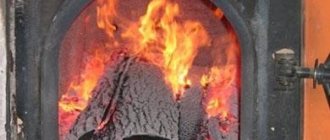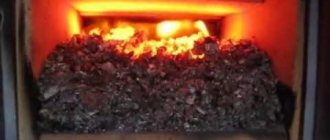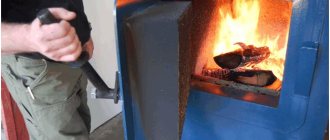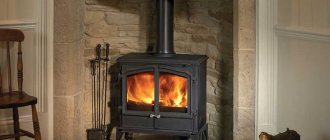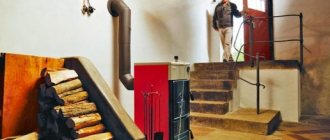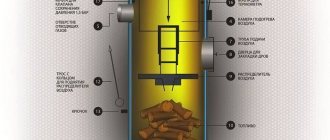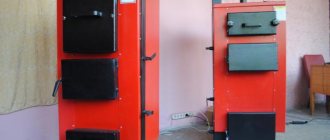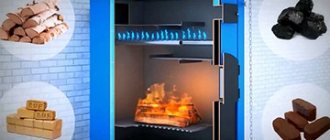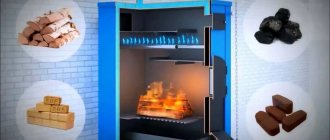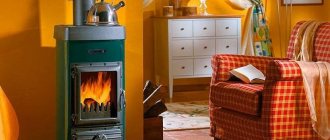The efficiency of any boiler depends on the correct ignition and combustion of fuel in it. To heat a device correctly, you need to know what features different types of fuel have and how best to light a fire in different types of devices.
In some boilers, coal, wood or pellets can burn from bottom to top, in others from top to bottom. In most long-burning devices, pellets or other fuel burns from the bottom up. These are pyrolysis and pellet devices. Some models of pyrolysis units allow you to burn pellets, wood and coal from top to bottom. This method is typical for the Stropuva and its analogues.
Preparing to light the fuel
This process is the same for all types of long-burning devices. It includes several stages:
- Cleaning the grates from ash . Move the ashes with a spatula over the grates. During this process, it falls down easily.
- Removing ash from the ash chamber . A spatula is used for this. Work carefully so as not to raise dust into the air.
- Wiping the walls of the firebox. To do this, use a dry cloth. This way they get rid of accumulated dust on the walls and future unpleasant odor that is formed when dust is burned during the burning of pellets, firewood or other types of fuel.
- Chimney cleaning. It is done very rarely. Before the first lighting of the new heating season, the chimney must be checked and cleaned.
Furnace Maintenance
To make the stove last longer, you need to follow several recommendations:
- Before the start of the heating season, seal cracks and gaps on the brick surface.
- Before and after winter, thoroughly clean the chimney. If the pipe becomes clogged more often, then do this as necessary.
- Do not forget to clean the grate and remove ash from the chamber before lighting.
- Do not use old things, bags, or plastic containers for the fire, which stick to the grates and emit acrid smoke.
- Clean chimney ducts from soot in a timely manner.
Keeping the stove clean allows the combustion process to occur as efficiently as possible.
Ignition of coal in pyrolysis boilers
If you plan to fire boilers with coal, you should always pay attention to the type of grate, because there are special modifications for each type of fuel. Many manufacturers often include coal grates in the kit.
Ignition of coal depends on whether the long-burning device has been used before and whether it has automatic controls for regulating the air supply. The main element of automation is the fan.
It is carried out like this:
- Open the scrambling door (second from the bottom) and place paper on the grate. Place thin paper or newspaper correctly.
- Special wood chips for ignition are poured onto the paper . It doesn't take much.
- Small firewood is placed on top.
- Crushed coal is placed on the firewood. Its consumption is high. The layer thickness should be 15 cm.
- The damper in the chimney is opened completely.
- They light the paper, close each door and turn on the automation, setting the required temperature level.
- After 5-10 minutes, check how the fire has flared up. To do this, turn off the automation and open the combustion door. It is better to open it slowly as the smoke output will be small. If the first portion of coal does not ignite, then close the door, turn on the automation and wait some more time. If the coal catches fire, the main portion of fuel is poured on top. Sprinkle correctly so that the cracks in the front part of the grate remain uncovered.
If a long-burning boiler is cold and has not been heated for a long time, then it is correct to light the coal using natural draft. This process is the same as igniting fuel in a long-burning device without a fan. After kindling, all doors are closed and the automatic control unit is turned on. He himself estimates the intensity of combustion, makes all the calculations and determines how much to heat the device.
Ignition of coal in pyrolysis boilers using natural draft
- Open the door of the fire chamber.
- Open the ash chamber door at an angle of 45° relative to the front wall of the heating device.
- Fully open the chimney damper. Thanks to this, traction will be maximum.
- They put paper on the grates, and wood chips on the paper. They set the paper on fire.
- Small firewood is placed on a small fire. Their consumption will be small. Close the firebox door.
- When the wood has flared up, open the firebox door, fill a third of the firebox with coal and close the door.
- After all the fuel has ignited, open the firebox and add coal. They fill the firebox to the top level of the fire door. If low-quality coal is used, it may coke. This can be avoided by mixing the fuel (this is very inconvenient) or laying a layer of firewood, then a layer of coal, then firewood and coal again. In the second case, coal consumption will decrease, and firewood consumption will increase.
- The ash door is closed halfway. If, in this position, smoke comes out through the ash pan, then it needs to be covered. It cannot be completely closed.
- As soon as the coolant in the system has become warm enough, the blower is covered so that a gap of 2-5 mm remains .
- Close the throttle in the chimney halfway. This position of the throttle and the blower will contribute to the most efficient operating mode of the solid fuel device. In this mode the device should operate until 9/10 of the loaded volume of coal is burned.
- When 9/10 of the fuel has burned, you can open the blower by 5 mm. Then wait until the coal burns out or add a new one.
- Before adding coal, the throttle is opened fully . They also open the vent slightly and wait 2-3 minutes. The increased draft will pull smoke out of the combustion chamber, causing less smoke to enter the room when the firebox door is opened. Then the door is opened and coal and firewood are added. The amount of fuel is taken based on how long the boiler will be heated. The door is closed.
- The next steps depend on how much coal and firewood (other fuel) was loaded. If the loaded volume is three times greater than the volume of fuel that was in the firebox, then the vent is opened at an angle of 30-45° for 5-10 minutes . After the fuel begins to smolder, the ashtray is returned to the position at which 2-5 mm is formed. gap.
- In the case of additional loading of such a volume of coal, which is less than half of the chamber, any regulatory actions and calculations are unnecessary.
How to keep your home warm longer with less wood consumption
You can achieve economical consumption of firewood and heat in your home if you do not open the vent too often.
Having added a new portion of firewood, when combustion is stable, you need to cover the ash pit and keep it in this position until a new addition. The temperature will be kept at the desired level and the wood will burn slowly and evenly.
Lighting coal in the Stropuva boiler
The most common method is to pour fuel into a container, pour the flammable mixture into the duct and throw a lit match or burning wick into it. But anthracite will not ignite like that.
For it to light up you need:
- Pour in enough coal to reach the level of the bottom edge of the loading door. The consumption in this case depends on the volume of the chamber.
- Place a layer of dry small firewood on the fuel. Its thickness should be two-thirds of the height of the loading door .
- Light the wood and close the door.
- Wait until the fire burns. You can evaluate the intensity of combustion by looking through a special window made of heat-resistant glass.
- When the wood has burned down to burning coals, you need to open the door and add coal so that the top of the fuel is even with the top of the fire door.
- Fully open the air duct to obtain maximum draft.
- Wait 30-60 minutes.
- If the oven begins to heat up, close the air duct back to normal.
- The boiler must be heated in this mode until the coal is completely burned.
The question of how to properly heat a solid fuel boiler directly depends on its type. All these units operating with solid fuel can be divided into two main groups - boilers with automatic fuel supply and units with physical loading.
The first group includes the so-called pellet heating products. Their design features are more complex, and the work is almost independent; it is necessary to heat such an apparatus, maintaining a fire in it, quite rarely.
The second type of solid fuel boilers is the most common. They come in three types:
- pyrolysis;
- classic;
- long burning.
Classic devices are practically not used today, this is due to the frequent need for their maintenance, as well as the insufficient safety of the unit for consumers. But pyrolysis apparatuses and long-burning boilers are widely used and popular. This popularity is due to their correct construction and fuel efficiency.
Rice. 1 Pyrolysis solid fuel boiler
Special cases
The same rules must be followed if you use a coal-fired stove. The slight difference is that such a stove is pre-heated in the same way as a wood-burning stove, then a small amount of medium-sized logs is loaded, and only after they have burned well can coal be added. The first backfill should have a thickness of no more than 5-6 cm, and only after the first layer has flared up, you can fill in the second - up to 15 cm thick. This will ensure uniform combustion and economical fuel consumption.
Pellets are a type of solid fuel in the form of granules made from sawdust. You can use pellets to heat a regular wood stove, the only condition is that the distance between the grates should be less than the size of the pellets themselves. Sometimes for this purpose a metal basket with small cells is placed in the firebox. But it is better to pay attention to pellet stoves specially designed for this type of fuel. The owner here only needs to select the combustion temperature, and the device will load the fuel, adjust the air supply and draft itself, since all processes in it are automated and controlled electronically. Those who wish can program it manually if they have knowledge of how to light a stove and an understanding of how this device works. In all other cases, it would be better to use the automatic mode.
How to heat a kitchen stove that runs on solid fuel? The only difference is that such stoves have a “summer” and “winter” flow of flue gases, regulated by two valves. In the summer, when the stove is used only for cooking, both valves are opened so that the smoke leaves faster and the room does not heat up. In winter, only one, the top valve, is opened so that the hot smoke warms up the entire body of the stove.
If you are heating your stove for the first time after purchasing it, you need to make sure that there are no parts or stickers left in the firebox, ash pan or ash pan. You should not immediately fill the firebox with wood or coal completely - for the first time it is enough to fill approximately 1/3 of its volume. The fire during the first heating should be small, and during subsequent fires you can gradually increase both the amount of fuel and the intensity of its combustion.
In the cold season, when heating the room is constantly needed, you should not allow the stove to cool completely, since each time it is reheated, additional fuel is consumed. For economical operation, the furnace is fired twice a day - for stoves with a long-burning function, and more - for stoves of conventional design. At the end of the process, you must make sure that the fuel has burned completely, and only then can you close the valve. A sign of completion of combustion is the absence of blue lights above the coals and a coating of ash formed on their surface. If there are smoldering embers left in the firebox, you can be poisoned by carbon monoxide, which is difficult to detect because it has no odor. In order to quickly extinguish the coals in the firebox, they can be sprinkled with sand, but they should not be filled with water, as this will cause the stove to malfunction.
Cleaning the stove and chimney should be done twice a year, since soot deposits and contamination of the chimney will not allow the system to warm up quickly, which means more fuel will have to be spent. In addition, a clogged chimney can lead to a fire due to the highly flammable soot. You can clean the chimney and stove yourself, but to achieve better results and get rid of this troublesome task, it makes sense to invite specialists. We hope that theoretical knowledge of how to properly heat a stove, complemented by practical skills, will help consumers save fuel and avoid troubles such as stove repair or fire.
Features of using a solid fuel pyrolysis boiler
Regardless of what you use to heat a solid fuel boiler, the principle of its use remains the same.
Option for lighting the unit with coal:
- small wood chips and additional paper, which is required for quick ignition, are placed in the fire door;
- Larger firewood is placed in the loading door, with a small amount of coal placed on top of it;
- the paper is set on fire, you need to wait a certain time before the wood chips are ignited and you can close the door.
After these operations, the device will solve the problem of maintaining the temperature independently. The owner’s only task will be to stir the coal from time to time, since some types of coal tend to coke. If you do not want to carry out such operations, it is better to spread the fuel in layers. That is, firewood, the above-mentioned black fuel on top, the other two layers in a similar sequence.
Tips for more efficient heating
If before refueling the boiler has recently been operating, and the chimney has excellent draft and has not yet lost its high temperature, it is enough to close the doors and, after turning on the control, record the desired temperature. After some time, you can remove the control unit and check whether the previously added part of the coal has ignited. If so, then it’s time to add additional combustion material. In this case, there is no need to close the slots in the front part of the grille.
Rice. 2 Automatic coal boiler
If the chimney is not preheated, after setting the paper on fire, the bottom door of the ash pan must be opened. Next, without turning on the fan, it is important to give the device some time to warm up using natural draft. After the combustion intensifies, its thrust will increase significantly; noticing this, you can close the door tightly and activate the control unit by turning it on.
When the chimney has not been used for a very long time, or it is new, it is worth warming it up well before lighting it. To do this, it is enough to set fire to the paper while inspecting the chimney until the draft in the boiler increases.
Basic methods of lighting a Russian stove
To properly heat the room, it is necessary to heat the stove at least once a day, more often it is fired twice. Initially, it is necessary to empty the interior of the stove from all unnecessary things: dishes, possible fuel residues, and clean the ash pan, furnace and firebox from ash. Then you can start kindling.
There are at least two main combustion methods:
The most profitable way is to burn wood in a firebox. At the same time, the stove heats up evenly and completely, and fuel is consumed economically.
Firewood is stacked in the firebox as tightly as possible, filling almost all of its space. The next stack of firewood is made after the first one has burned down to the state of coals. Before this, the coals are moved further away in order to avoid crushing them and extinguishing all the sparks in them. The second installation and all subsequent ones should be one third less than the first.
Scheme of a Russian stove with a radiator.
When kindling, the valve at the mouth must be closed well. Open the stove valve slightly, and, on the contrary, close the ventilation valve. Such actions are performed to improve traction. However, when lighting, a small amount of smoke may still return because the stove is not yet warmed up. To solve this problem, it is enough to move the ventilation valve 2-3 cm. After some time, be sure to push it back to its original position.
For sustainable stability of the combustion process, constant access of oxygen is required. To do this, you periodically need to “stir” the woodwork with a poker. At the same time, oxygen penetrates to the lowest layers of firewood and the combustion process intensifies. Before opening the oven door, it is necessary to close the vent. This will help moderate the flames during direct contact with the fire and reduce smoke.
You can ignite a flame in a stove using one of two methods: top or bottom. The easiest and fastest way is the bottom one. In this case, flammable materials are placed in the center under the masonry. Such actions will help to quickly ignite any fuel. This is also the disadvantage of this method - oxygen will burn quickly, and the stove will be heated unevenly, which will lead to already known consequences.
It would be more correct to use the top ignition method. It is not difficult to guess that it involves placing kindling on top of the firewood. This ensures the most uniform heating of the stove and smooth spread of the flame along the wood stack. This will reduce the load on the stove firebox.
During combustion, it is necessary to keep the ash door open approximately 7 cm.
Combined Russian masonry scheme.
The second method is called kindling “in Russian” and is done on a hearth. The stove valve is closed and the ventilation is kept open. The firewood is placed in a well at the front edge of the furnace, lit and then slowly moved to the central part. For maximum ease, the firewood should be completely dry. This method is best used when rapid heating of the room is not required. It is convenient for cooking stewed food or using the stove as a fireplace. At the same time, you should carefully monitor the firewood so that coals or sparks do not spill out of the stove.
The firing time, on average, should be limited to two hours for long-term service of the stove and to avoid cracking of its walls. After firing, be sure to close the mouth and existing valves. Thanks to this, dishes in the oven will cook faster, and the house will cool down more slowly.
Quick and proper lighting of the stove is facilitated by the correctly chosen method of stacking firewood in the hearth. Most often, firewood is stacked in parallel, either in a “hut” or in a well. Parallel stacking involves the arrangement of logs straight, sequentially stacked on top of each other in layers. For free access of oxygen, it is necessary to leave sufficiently large gaps in the masonry, as if producing it in a checkerboard pattern. The logs are laid out in a “hut” standing in a circle, and then they are tilted all towards the center. The result should be a closed cone. With this method, the firewood is engulfed in flame along its entire length and burns faster. It is more correct to heat the stove using a parallel bookmark.
Working with a long-burning boiler
The question of how to heat a long-burning solid fuel boiler is multivariate, since the boiler can heat both by combustion and by layer. This feature allows you to significantly increase the operating time of the unit with just one load.
Loading and lighting the device is quite simple:
- Firewood is placed upward in the firebox;
- chips and paper are added through the loading door;
- the paper is set on fire, you must wait until the wood chips ignite;
- when the door is closed, you can turn on the control unit.
If all the steps have been performed correctly, the top layer will gradually begin to flare up; while the unit is operating, the entire filling will burn through from top to bottom.
In some cases, when the entire system has not fully warmed up, a small amount of barely visible condensation may appear on the walls of the heat exchanger. Sometimes this liquid can leak out of the hatches, forming small puddles on the floor. Mostly this situation is temporary. A boiler that has proper circulation will no longer produce condensation after heating the system.
Immediately after turning on the control system, it is better to leave the solid fuel device in operating mode with a high temperature. In this case, the room and the unit itself will warm up faster, after which the temperature can be reduced.
The main components of a Russian stove
Conventionally, the stove can be divided into three main blocks - a firebox, a chimney and a pipe. The firebox is a special compartment for storing fuel. An ash pan is always placed under the firebox; this is an essential part of any stove. The ash pit provides the supply of oxygen necessary for combustion to the firebox, and is also a container for the accumulation of ash from burnt wood. The chimney is designed to remove smoke and excess thermal energy from the stove firebox. When designing a chimney, several zigzag turns are planned inside to heat one of the walls in the house. The walls of the chimney should be made smooth to avoid rapid clogging. The pipe ensures that smoke is discharged directly to the street. The pipe of a Russian stove must be well insulated, since its heating temperature is quite high.
It is necessary to clarify certain terms that characterize the Russian stove. An under-oven or under-oven is a special compartment for storing a supply of firewood in the very bottom part of the oven. Dishes were often stored on the shelf. The six is provided for ease of cooking. The stoves installed in the body of the furnaces served to improve heat transfer and drying of workpieces. The cheeks are the front part of the stove. Firewood is laid through the mouth. The crucible is a place where fuel is burned. Hailo leads the smoke to the chimney. And the roof was used as a warm lounger.
Choosing fuel for a solid fuel boiler
Many users of solid fuel boilers are very careful when choosing fuel. This is not at all surprising, since the quality operation of the unit depends on this product. Moreover, it needs to be purchased in large quantities, not only because of the cold climate, but also because the long-burning device requires refilling with large quantities of raw materials.
The following types of gas stations are considered the most popular today:
Not knowing what is the best way to heat a solid fuel boiler, you should pay attention to briquettes and pellets, which are easy to use and have a long burning time. But when using them, there is also a significant disadvantage - the high price, which is derived from the difficulty of manufacturing these products.
Firewood is no less convenient to use, but in some cases it has high humidity, which is difficult to deal with even for the newest boiler models.
But heating with coal is beneficial from all sides - its combustible effect is quite long, and during combustion it does not emit any harmful substances. The low price of the material is no less pleasing.
Liquid fuel designs
When considering various design options, it is worth remembering about a long-burning furnace that runs on technical oils. The stove operates by burning oil vapor. The burning time is comparable to solid fuel designs and ranges from 12 to 20 hours per refill. It is economically profitable to use such units where there is a large volume of mining. The disadvantages include the need for frequent cleaning of chimneys, or the need to pre-clean the oil.
Periodic boiler cleaning
After learning how to fire a coal boiler, you need to learn how to clean it. These actions will help prolong the performance and neat appearance of the unit. During the smoldering process of coal at high temperatures, the device leaves a minimal amount of waste, which is dumped into the ash pit. The amount of waste is practically invisible; it becomes visible only after prolonged use of the device.
The entire combustion process takes place on a grate. But over time, the time comes when the solid fuel boiler needs to be cleaned. Such cleanup activities are not considered particularly time- or financially expensive.
You don’t have to worry about the best way to clean the device: any specialized store offers a large number of products used to clean soot and tar from boilers.
These products are thrown directly onto hot coals, resulting in the formation of acrid smoke, which will remove all the toxins inside the boiler and chimney. In this case, the operation of the device can not be interrupted. In addition, the walls of the device can be cleaned with a brush and a wire brush, which are usually included when purchasing the equipment.
Caring for a Russian stove
It is important to know not only how to heat a Russian stove, but also how to properly care for it. All furnace passages and working chambers should be cleaned in a timely manner. The ash compartment is cleaned of accumulated ash every time the firebox is completed. First, its remains in the hearth are swept into the ash pit to be completely removed, for which they use a shuffle - a special metal scoop attached to a long handle.
Typically, major cleaning is carried out once a year on the eve of the heating season. When carrying out cleaning, openings are used that are closed by doors that are provided in the design. This procedure is performed with a poker. It is used to remove the remaining ash and soot accumulated on the inner surfaces of the walls through open holes.
You can remove plaque more thoroughly with a broom made of hard rods. After cleaning, the doors of the openings are tightly closed. The chimney is cleaned of soot, condensation or foreign objects once a year with a special hose or rope with a weight at the end. But in this case it is better to use the help of specialists.
Why is a solid fuel boiler an economical solution?
The choice of device is primarily correct for residents of dachas and cottages not connected to centralized heating. Even if such a connection is present, this unit will help to significantly save on gas bills; solid fuel is widely available and has a low price.
On the modern market you can find suitable equipment for planning a house of any complexity, even with a fairly large area. Having studied the above recommendations on how to use and maintain the boiler, these actions will take a minimum of time.
The same amount of wood can burn at different speeds and produce different amounts of heat. Next, we will tell you how you can increase the efficiency of burning wood: extend its burning time, increase heat transfer and reduce consumption without special costs.
This is the second article in a series about efficient wood burning:
Alexander Batsulin
Born in Moscow on September 7, 1976.
Graduated from the Faculty of Chemistry of Moscow State University with a degree in Chemical Kinetics. He has been involved in the furnace business since 2000. Interests: construction and design of stoves for heating individual houses. Traditional timber construction. Tel. 8 (915) 169 1733 8 (950) 259-6401 e-mail: sashbats (а) mail.ru Russian Teplushka stove is designed for heating a room and cooking food by boiling, simmering, baking and frying. The oven can also be used for drying herbs, mushrooms, berries, apples, plums, pears, etc.
Proper stacking of firewood
Typically, firewood is set on fire like this: they build a pyramid of logs, put paper and wood chips in the center and set it on fire. First, the wood chips flare up, and over time, the firewood itself. The disadvantage of this method is that you do not control the combustion. The firewood ignites all at once and entirely, burning unevenly and quickly. When some of the logs burn out, you throw in new ones, which will also quickly flare up and burn.
The burning time of firewood can be increased by changing the way it is placed in the firebox. For example:
- Lay the first bottom row of firewood.
- Place the second row on top, shifted to the right or left by 5-10cm to form a ledge. Place the third and subsequent rows on top.
- Place paper or wood chips near the edge with the ledge and set them on fire.
Laying using fuel briquettes as an example. The briquettes do not ignite entirely, but burn evenly: the flame gradually moves from left to right. A stack of firewood burns for a long time and produces a sufficient amount of heat.
- Do not place firewood close to each other. Leave a small gap between them for air movement.
- The denser and drier the wood, the more evenly it burns and the easier it is to ignite.
Step-by-step instructions on how to quickly light the stove
Kindling is done like this:
- Pieces of crumpled paper are placed in the firebox, with chips of logs, dry tree branches, and birch bark on top. After that, several large logs are placed - the firebox should be only a third full - and set on fire. The damper damper and the blower door must be completely open. The firebox door closes.
- As soon as the fire is well lit, you can load the firewood by laying it in a cage pattern across the grates. There should be at least 10 cm left to the top. The blower door, the gate is closed a little.
- The combustion process must be controlled and regulated by furnace valves. The fire in the stove should be yellow.
- It is better to use logs of the same size for the main stash. There will be no risk that the fire will go out, and the wood will burn evenly.
- To complete the fire, the coals are pulled to the center, wait until they burn out completely, and close all the dampers.
When closed, the oven will retain and release heat for several more hours.
Close the valve in a timely manner
The stronger the draft, the faster the wood burns. But if there is not enough air, they burn poorly and form a lot of soot. Balance is important so that the minimum amount of air necessary for combustion reaches the firewood.
- Before ignition, open the heater damper to the maximum to ensure good draft for igniting the wood.
- When the wood starts to burn, begin to gradually close the valve. If the firewood starts to go out, open the valve slightly and increase the draft. Over time, you will find the optimal valve position.
The drier and denser the wood, the less air is required to burn it.
Requirements for dishes
If you remember, grandmothers in the villages had a lot of cast iron cookware. It is ideal for a Russian stove. The bottom of the cast iron pan was small in diameter, and the walls were thick. Such utensils were suitable for preparing soups, cereals, meat, and fish. To fry any product, cast iron frying pans were used.
REFERENCE! In a Russian oven, many dishes are fried on only one side. For example, pancakes. They are not turned over. At the same time, make sure that the bottom of the cast iron frying pan is clean and smooth. Any irregularities can result in a burnt dish.
In addition to cast iron, clay is popular. Clay dishes are not so strong and durable, but with proper care they can delight you with delicious cereals, simple soups and stewed vegetables. Clay pots are most often used. Their pot-bellied shape is ideal for simmering, and their small volume allows you to cook food in portions.
Aluminum cookware is in third place in popularity. It should be thick-walled. Aluminum is not inferior in strength to cast iron.
Modernity leaves its mark even on traditional life. Today, housewives use dishes made of heat-resistant glass. These kitchen utensils are convenient and widely available, and are also cheaper than cast iron cookware.
REFERENCE! Any utensils intended for simmering must have lids. This way the beneficial properties of the products remain in the food.
What kind of wood is better to burn?
The heat output of the heating device and the burning time greatly depend on the type of wood.
At the molecular level, wood consists of many empty cells with walls made of woody matter. The density of this woody substance (walls) is the same for all types of wood, but the size of the cells is different.
The smaller the size of the cells, the higher the density of the wood and each square centimeter contains a lot of flammable wood matter. And vice versa: the larger the size of the cells, the lower the density of the tree. It contains a lot of air and little flammable wood matter.
Imagine that a circle is 1 square centimeter of wood. In the first case, the cells are small and there are many walls between them. In the second case, the number of cells and walls is smaller, and there are more voids filled with air. The density of such wood is low.
What conclusions can be drawn:
- Less dense wood burns quickly . When wood burns, air is released, which fuels the combustion. The more air, the firewood burns faster and less evenly.
- Dense firewood produces more heat because it contains more combustible wood matter per unit volume.
- Dense firewood leaves more coals , which take a long time to smolder. Soft woods hold their shape less well, crumble into small coals and go out quickly.
Prohibited
- Use gasoline and other flammable liquids to light the stove. This leads to an explosion and fire.
- Burn household waste, polymers, roofing felt, roofing felt, old shoes, etc. in the stove. This leads to clogging of the stove with difficult-to-remove resinous soot and an unpleasant odor in the house.
- Heat with raw wood. A significant amount of heat is expended to evaporate the moisture contained in the firewood. Firewood is considered air-dry if it has been stored under cover for 1 year. If there is no dry firewood, then a two to three day supply of wet firewood is dried in the house (near the stove).
- It is prohibited to heat the stove with the combustion door open.
- Burn in the oven color magazines on coated paper such as “Liza”, “7 days”, “Relax”, “TV Park”, “Cosmopolitan”, “Men’s Health” and similar Russian and foreign publishers. The abundance of printing ink on their pages prevents the complete combustion of the paper - the ash from them does not fall into the ash pan, but remains in the firebox, clogs it and prevents the normal combustion of firewood. In addition, such ash should not be used to fertilize the garden for environmental reasons.
- Heat the stove with sawdust, shavings and similar woodworking waste. This fuel completely covers the grate. Continuing to smolder in the absence of air, it releases flammable gases that fill the entire convective system of the furnace. And then, with the subsequent entry of air and the breakthrough of the flame, an EXPLOSION may occur. It is especially dangerous to put sawdust into an already heated firebox.
- Cover the roof (top) of the stove with combustible materials. This leads to fires.
- Fill the space between the stove and the wall with combustible materials (firewood, clothing, etc.). This causes a fire and also reduces the heat transfer of the oven, preventing convection. In addition, drying is ineffective in a confined space without air movement.
- Reheat the stoves. The temperature of the furnace walls should not exceed 70 °C. If necessary, it is better to fire the stove more often than usual rather than use a forced firebox. This leads to destruction of the oven and creates a fire hazard.
- Lighting a stove in an unfinished house. The absence of a proper thermal circuit of the room will inevitably lead to overheating of the stove.
Prepare firewood in advance
Bring the wood into a warm room 2-3 days before lighting to increase its initial temperature.
The warmer the wood is initially, the:
- They spend less heat on their own heating and more on heating the room. You use heat more beneficially.
- Firewood reaches its optimal combustion mode faster, which further increases its calorific value and reduces the amount of soot emitted. This happens because the resin, creosote, tar, essential oils and other substances contained in wood do not burn at low temperatures and are deposited on the walls in the form of soot. And under optimal conditions, the combustion temperature is sufficient for them to burn entirely and release additional heat.
The difference between the combustion of “warm” and “cold” firewood is immediately noticeable: cold firewood produces a lot of smoke, which characterizes incomplete combustion. And warm, dry wood burns with virtually no smoke.
Preheat the firebox
When wood starts to burn in a cold firebox, then:
- part of the heat is spent on heating the firebox, and not heating the room (as in the previous point).
- It is more difficult for them to flare up, since warm air overcomes the resistance of cold air in the chimney.
Basic firewood is best lit in a preheated firebox so that it does not waste extra energy heating the firebox and chimney. You can use the heat from the previous stack of firewood or pre-burn the prepared torches and paper in the firebox.
When is it necessary to add firewood to a stove firebox?
To determine when it's time to add more firewood, it's important to consider the following:
- A new pile of firewood should be done when good smoldering coals remain from the previous one. If you do this earlier, it is simply an uneconomical use of fuel.
- The logs need to be laid across the grate, slightly away from the furnace door (combustion chamber). After adding firewood, the firebox doors must be closed immediately so as not to disturb the normal air exchange in the stove.
- It is important to check and periodically clean the ash pit from accumulated ash. Excessive amounts of it can interfere with normal traction.
It is important to clean the surface of the furnace equipment from dust at least occasionally. After all, when heated to a high temperature, the dust on the surface will begin to burn and emit an unpleasant aroma.
Use bottom combustion (if possible)
There are two ways to burn wood: grate (bottom) and hearth (top burning).
Bottom burning is traditional, when air enters the firewood from below and the flame gradually moves upward. With top burning, air is supplied to the wood from above, the fire also burns at the top and gradually falls down.
With hearth burning, the largest logs are laid below, and paper and smaller firewood are placed on top.
- The completeness of combustion of wood increases, due to which they release more heat.
- You reduce the release of volatile substances that pollute the chimney with soot.
- This is a more environmentally friendly way of burning.
How to do it
For hearth burning, the firewood is stacked in a pyramid: the largest logs are placed at the bottom, and the smaller ones at the top. At the very top, wood chips and paper are set on fire.
While the wood chips and paper are burning, the firebox warms up. The flame then begins to move downwards and ignite the main wood. At this point, the combustion temperature and flame intensity are sufficient for the volatile substances that make up the wood to begin to burn. Due to the completeness of combustion, firewood releases more heat, and due to uniform combustion, it burns for a long time and economically.
Combustion process
The first ignition took place. Now you need to start the second batch of already prepared firewood. When the hearth is heated, you can burn with whole logs. However, there is no need to lay too large logs, as the fire may not be able to cope with them.
In addition, they form long-smoldering coals, which is inefficient in terms of fuel use. Most of the heat will be carried away into the chimney by air, which significantly reduces efficiency. You need to carefully remove too large firewood, postponing its use for a while. It is also important to turn over those logs that burn weakly in time and try to maintain an even distribution of fire inside the firebox.
The longer the combustion process lasts, the more you need to ensure that the flame inside the firebox burns evenly. You need to get maximum heat from the coals to heat the house. This can be achieved by turning the coals. It also promotes a greater flow of oxygen. The chimney channel must be closed when the burning flame turns from blue to white.
There are specifics for lighting stoves depending on the material from which they are made. Fireplaces made of stone, concrete and brick require a lot of effort when lighting them. It takes at least an hour to ignite. The fireplace takes the most time. When lighting a fireplace with an open flame, you should always be nearby for safety reasons.
How to light a stove with coal:
Do not allow wood to burn too high
There are three wood burning modes: low, high and optimal.
When the mode is reduced, the firewood does not burn completely and produces a lot of soot. If it is higher, you waste firewood: part of the heat flies away through the chimney, since the heat exchanger and the room do not have time to remove it completely. This occurs in two cases: you use too much wood or supply too much air. It is necessary to reduce the volume of the bookmark or draft.
The best option is when the wood burns in the optimal mode: not weakly and not strongly. The easiest way to determine the combustion mode is to use a combustion indicator, which shows the current mode in real time. If the temperature of the flue gases is more than 320 degrees, then the firewood burns at high speed.
The combustion indicator determines the flue gas temperature and combustion mode in real time
What type of wood is best for firewood?
Different types of wood differ from each other in their calorific value and combustion characteristics. In this regard, when choosing fuel, you need to understand the performance characteristics of firewood.
- Pine has a high combustion temperature. The reason for this is the high resin content. This rock suggests many voids where tar deposits are present. When burning, they produce micro-explosions, sparks and ignited pieces of wood fly away.
- Spruce is less efficient in a firebox than pine. It contains less resins. Splitting wood is easy, but when burning the tree smolders and smokes. These conifers can be used for heating only in extreme cases.
- Alder. The main feature is the ability to burn without forming soot. At the same time, during combustion, deposits in the chimney will also be burned out. Such characteristics are unique to aspen.
- Poplar. It burns out quickly without providing enough heat. It should not be used to heat a bathhouse, but it is quite suitable for a home.
- Birch. Burns hotter than beech with acacia and oak. But there is also a drawback, and a significant one. It is necessary that there is sufficient air flow into the combustion chamber. Otherwise, there will be no heat, but only tar and smoke on the walls of the chimney.
- Oak. It is distinguished by its high density and ability to release heat. Its characteristics are similar to ash and also resemble beech. Oak wood is quite heavy when splitting.
- Maple. Its wood burns quickly without forming coals, as a result, there is a need to constantly add fuel. It's like burning linden wood.
- Apple trees. Like other fruit species, it pricks well and produces enough heat when burning. Apple firewood is also preferred because of the pleasant smell in the room.
Here's what else the stove maker said.
There are not enough banking services: what restrictions hinder the self-employed in 2022
Rarely take vacations: strange work habits of Americans
Fateful acquaintance: how Bill Gates was able to achieve such success
Remove soot promptly
Soot needs to be removed not only when the chimney is clogged and there is no draft, but regularly. Soot not only impairs chimney draft, but also serves as thermal insulation. It covers the internal walls of the heating device and the heat exchanger, which reduces their heat transfer. If soot is removed in a timely manner, the volume of wood burned can be reduced without loss of heating power.
Obvious, but worth remembering: the firewood must be dry. Wet wood does not ignite well, goes out quickly and emits 2-2.5 times less heat than dry wood.
What is best to use for cleaning a chimney?
Chimney maintenance needs to be done periodically. Soot and resin deposits are removed from it. There are following reasons for this:
- The internal lumen becomes overgrown, causing traction to deteriorate and, accordingly, heat transfer decreases.
- If there is insufficient draft in the chimney, then a reverse draft effect may occur. Instead of going outside, the smoke will return indoors, which is the cause of carbon monoxide poisoning.
- Having reached a critical level, the soot ignites. Essentially, a micro-explosion occurs inside the chimney. During combustion, a lot of heat is released and heating occurs up to 1200 ° C. Then the chimney requires major repairs.
To prevent the condition of the chimney, among other things, in case of small deposits, burn aspen or alder firewood. The oven needs to be heated thoroughly. In addition to firewood, briquettes that have a special chemical composition are also used. However, if there are large soot deposits inside the chimney, burning off the tar will not help. Then mechanical cleaning of pipes is inevitable.
Conclusions: how to properly heat with wood
- Stack firewood carefully so that it burns evenly and for a long time.
- Close the air valve in a timely manner. The minimum amount of air required for combustion must reach the firewood.
- Dense wood burns longer and leaves more long-smoldering embers. It is best to burn with wood from hard deciduous wood: maple, walnut, birch, cherry, larch, beech, oak, sycamore, pear, apple tree
- Bring the firewood into the house 2-3 days before lighting it and place it in the firebox an hour before lighting it.
- Preheat the firebox with a small amount of splinters.
- If you have a fireplace or stove, use bottom combustion.
- Maintain optimal combustion conditions. If the wood burns too hot, some of the heat escapes into the chimney rather than remaining in the room.
- Change the volume of firewood depending on the outside temperature.
- Remove soot in a timely manner. Soot is a thermal insulator and reduces the heat transfer of the heating device and heat exchanger.
- Firewood should be as dry as possible.
Add your own ideas to the comments.
| Wood species | |
| Low density 0.15 – 0.55 g/cm 3 | Spruce, Willow, Aspen, Pine, Linden, Alder, Siberian Fir, Poplar |
| Average density 0.56 – 0.70 g/cm3 | Maple, Walnut, Birch, Cherry, Larch, Beech, Oak, Sycamore, Pear, Apple tree |
| High density 0.75 – 1.08 g/cm3 | Ash, Plum, Boxwood, Ebony persimmon, Acacia |
Safety precautions: how not to get burned by the stove
The main dangers of stove heating are toxic carbon monoxide, the risk of fire and burns. To avoid this, it is important to follow a few tips:
- Check the condition of the stove and chimney ducts before starting the fire.
- Do not use gasoline or other flammable mixtures for kindling.
- Try to always finish heating a few hours before bedtime.
- Do not accelerate the oven above the permissible temperature.
- When installing the stove, adhere to fire safety.
- Keep children away from the stove equipment. Do not leave them alone with a hot oven.
- Do not place furniture or interior items near the stove that can quickly catch fire.
By adhering to basic safety rules when operating the stove, you can avoid irreversible consequences and not put the health of loved ones at risk.
